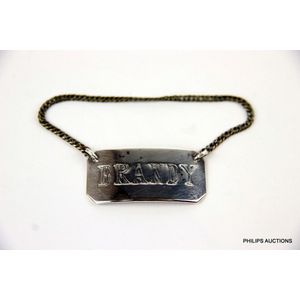Australian Colonial Silver Brandy Decanter Label, 1870-1875
You must be a subscriber, and be logged in to view price and dealer details.
Subscribe Now to view actual auction price for this item
When you subscribe, you have the option of setting the currency in which to display prices to $Au, $US, $NZ or Stg.
- Hallmarks - A mark stamped on articles of precious metals in Britain, since the 14th century, certifying their purity. It derives its name from the Guild Hall of the Goldsmiths' Company, who recieved its Charter in 1327 giving it the power to assay (test the purity) and mark articles of gold and silver.
The hallmark will consist of several marks, including the:
- silver standard mark, indicating the purity of the metal. Sterling silver is .925 pure silver.
- the city mark indicating the city in which it was assayed eg London, Birmingham, York etc.
- the date mark, usually a letter of the alphabet in a particular font and case,
- a duty mark, indicating whether duty had been paid to the crown, and only in use from 1784 to 1890
The piece may include an additional mark, the maker's mark, although not forming part of the hallmark, will be located in the vicinity of the hallmarks.
Sometimes silver plated items will bear faux hallmarks, often confusing those not familiar with silver markings. - Canted Corners - In decorative arts, especially furniture making, a canted corner refers to a technique where the corner of the piece is angled or "canted" to create a diagonal corner. This is different from a chamfered corner which is a technique where the edges of a corner are cut at an angle, creating a diagonal edge or "bevel" along the corner.
A canted corner is typically used to add visual interest to the item. It can be found in various styles of furniture such as contemporary, Art Deco, or traditional. It is often used to create a sense of movement and dynamism in a piece.
Canting a corner is a more complex technique than chamfering, and it is typically done by tilting the corner of a piece of furniture and then cutting the wood to match the angle. It's a technique that requires precise measurements and a good understanding of angles and geometry, and it is usually done by experienced artisans.
This item has been included into following indexes:
Visually similar items

A pearl and agate pendant necklace, possibly Maryln Westraten, signed, in sterling silver.

A turquoise-glazed moon flask Qing dynasty, 18th century of multi-lobed form and oval section, the rounded sides springing from a waisted foot, tapering to the incurved mouth, covered with a bright turquoise glaze falling unevenly short of the splayed foot

Good Georgian cut glass lidded honey jar, height 18 cm, chips to inner rim of jar

Pair of antique French cast iron garden urns, 38 cm high, 26 cm diameter (2)
